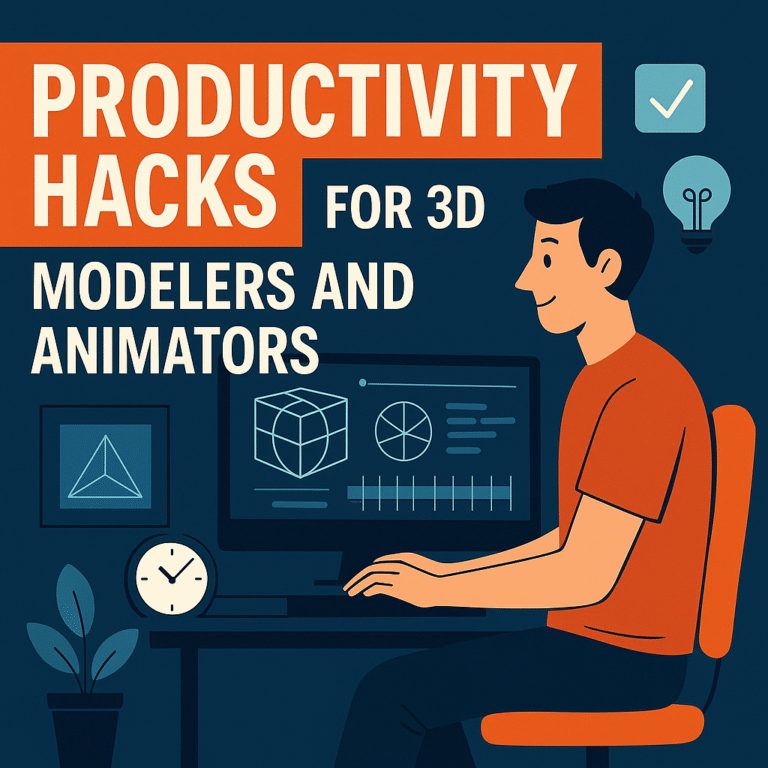If you want to learn 3D modeling to make money, this guide shows a clear path from zero to your first paid work. You will pick a niche, choose the right software, follow a simple plan, and build a small portfolio that clients trust. The goal is finished projects and steady progress, not perfection.
You can use these steps part time or full time. Publish your work often, ask for feedback, and improve one skill each week. That is how you learn 3D modeling to make money without getting stuck.
Pick your 3D path
Start with one path so you do not get overwhelmed. Each path looks for different skills and examples in a beginner portfolio. Choosing a lane helps you learn 3D modeling to make money faster because your practice matches what real buyers need.
- Games
Create props, environments, trim sheets, and optimized low poly assets with clean UVs and bakes. Show wireframes and triangle counts. - Film and animation
Sculpt characters and creatures. Build hard surface models and set pieces. Show clean topology and simple deformation tests. - Archviz and product
Model furniture, interiors, exteriors, and consumer products. Focus on accurate scale, materials, and lighting for photoreal results. - Motion graphics
Make logo animations, abstract loops, product stings, and titles. Keep scenes tidy and renders consistent across versions. - 3D printing
Design printable miniatures, tools, and cosplay parts. Show wall thickness, supports, and a short assembly note.
Choose your software stack
You do not need every tool. Pick one main app and add others as your projects grow. These options are trusted by studios and freelancers.
- Blender
All round modeling, UVs, sculpting, and rendering in one free package. Great for beginners and pros.
Outbound link: https://www.blender.org/ - Autodesk Maya
Used widely for animation and game pipelines. Strong rigging and animation tools.
Outbound link: https://www.autodesk.com/products/maya/overview - Autodesk 3ds Max
Popular for modeling and archviz. Known for modifiers and stable workflows.
Outbound link: https://www.autodesk.com/products/3ds-max/overview - Cinema 4D
Favored by motion designers for fast iteration and MoGraph tools.
Outbound link: https://www.maxon.net/cinema-4d - ZBrush
Industry standard for high detail sculpting and concepting.
Outbound link: https://www.maxon.net/zbrush - Substance 3D Painter
Paint PBR textures on your models and export clean maps.
Outbound link: https://www.adobe.com/products/substance3d-painter.html
How to choose quickly:
- If you want a free full pipeline, start with Blender and add Substance 3D Painter when you begin selling assets or taking gigs.
- If you plan to work in studios that focus on animation or games, learn Maya basics and keep Blender for personal work.
- If you aim at archviz or product renders, 3ds Max or Cinema 4D is often a strong match.
Hardware basics
Good hardware will help you learn 3D modeling to make money faster, but you do not need a high end rig to start. Upgrade in this order.
- GPU first
Your graphics card drives viewport speed and renders. Aim for a recent mid range card. Install the latest drivers.
Nvidia Studio drivers: https://www.nvidia.com/studio/
AMD Adrenalin drivers: https://www.amd.com/en/products/software/adrenalin - RAM next
16 GB is workable for small scenes. 32 GB feels smoother when you add textures and higher poly counts. - CPU and storage
Any modern 6 to 8 core CPU is fine for beginners. Use an SSD and keep assets on a fast drive. Name files clearly. - Monitor and input
A 24 to 27 inch 1080p or 1440p screen is easy on the eyes. A basic pen tablet helps with sculpting but is optional. - Quick check
Review your software’s official requirements before you buy parts. Blender system requirements: https://www.blender.org/download/requirements/
If you want a simple way to stay consistent while you upgrade, read our Skill Building tutorials: https://skilldemia.com/category/online-business-tutorials/skill-building-tutorials/
30 day beginner roadmap
Follow this plan if you want to learn 3D modeling to make money as soon as possible. Keep sessions short, finish small projects, and publish your work.
Week 1: learn the tool
- Master navigation, transforms, snapping, and modifiers.
- Model 10 simple objects. Keep scenes tidy.
- Post one turntable at the end of the week.
Week 2: clean modeling
- Study quads, edge flow, and subdivision control.
- Rebuild one prop three times until the wireframe looks clean.
- Read this topology primer: https://wiki.polycount.com/wiki/Topology
Week 3: UVs, texturing, lighting
- Mark seams, unwrap, and pack islands.
- Create one simple PBR material and light a small scene.
- Learn how PBR works: https://www.adobe.com/products/substance3d-painter.html
Week 4: mini projects and publishing
- Build one hero prop and one small environment.
- Render stills and a short loop.
- Publish your pieces on ArtStation: https://www.artstation.com/
When you finish this month, you should have two portfolio pieces and a clear path to your first paid gig. For ideas on turning those skills into income, browse our Make Money guides: https://skilldemia.com/category/make-money/
Core skills to master next
Once you can finish small projects, focus on the skills that clients notice. These make it easier to learn 3D modeling to make money at a steady pace.
- Clean topology
Use mostly quads. Control edge flow around curves and deformations. Check the wireframe at subdivision level one and two. - UV unwrapping
Mark seams in hidden areas. Pack islands tightly. Maintain even texel density so details look consistent. - PBR texturing
Work with base color, roughness, and metalness maps. Keep values in a believable range. Learn smart masks and procedural layers. - Lighting and presentation
Use simple three point lighting. Show a clay render, a beauty render, and a wireframe. Add a short text breakdown that explains what you solved. - File hygiene
Name files clearly, keep folders clean, and version your work. Teams care about this as much as your art. - Feedback loop
Post work in progress shots and ask for one specific note at a time. Tight feedback helps you learn 3D modeling to make money without wasting hours.
Build a portfolio that gets replies
Your portfolio is proof that you can learn 3D modeling to make money and finish real work. Aim for three to five strong pieces that match the path you picked.
- Show a clean wireframe, triangle counts, and texture sets for each piece.
- Include breakdowns: one paragraph on your brief, references, challenges, and what you solved.
- Present beauty renders, a clay render, and one short turntable.
- Keep filenames and folders tidy so teams can trust your handoff.
- Host on platforms clients actually browse: ArtStation, Behance, and Sketchfab.
If you need help with habits while you build, read our Skill Building tutorials: https://skilldemia.com/category/online-business-tutorials/skill-building-tutorials/
Monetization paths
There are many ways to learn 3D modeling to make money. Pick one path and focus for 60 to 90 days.
Sell 3D assets
- What sells: props, trim sheets, kitbash sets, materials, characters, rigs, printable models.
- Where to sell: Blender Market, CGTrader, Sketchfab Store, Unreal Marketplace, Unity Asset Store, Etsy.
- Quick start: pick one niche, create a 10 asset pack, document usage, include renders, wires, and a changelog.
Freelance services
- Offers: prop modeling, environment blocks, product visuals, logo stings, printable model design.
- Finding clients: personal outreach to small studios, LinkedIn, local agencies, and niche Discords.
- Starter package: clear scope, two milestones, two rounds of edits, source files on final payment.
Get a job
- Roles: junior prop artist, environment artist, 3D generalist, motion designer, 3D printing tech.
- What to show: game ready models, baked maps, breakdowns, and one page resume.
- Apply small to large: indie shops first, then bigger studios as your portfolio grows.
Animate short loops
- Product spins, logo reveals, and abstract loops used in ads and social videos.
- Keep loops under 10 seconds, export in common aspect ratios, and deliver editable project files.
3D printing
- Design with wall thickness and supports in mind.
- Offer STL packs, simple assembly notes, and a license for personal or small commercial use.
Social media
- Post timelapses, before and afters, and wireframe vs render comparisons.
- Use call to actions that lead to your shop or contact form.
Courses and coaching
- When you have results, turn your process into a mini course or workshop.
- Host on your site or platforms like Gumroad and Udemy.
For more earning ideas, explore our Make Money hub: https://skilldemia.com/category/make-money/
Pricing starter guide
Price by scope, not just hours. Clear terms help you learn 3D modeling to make money without confusion.
- Define deliverables: model list, poly budget, maps, formats, and deadline.
- Revisions: include two rounds, then charge a flat fee per extra round.
- Usage rights: personal, commercial, or exclusive. Exclusive costs more.
- Rush fees: add a surcharge for tight deadlines.
- Milestones: 30 to 50 percent upfront, mid project checkpoint, final on delivery.
- Deposits: do not start work until the deposit clears.
- Invoices and contracts: keep a simple template that spells out scope, timeline, and rights.
Action checklist
Use this checklist to learn 3D modeling to make money in a focused way.
- Pick one path: games, film, archviz, motion, or 3D printing.
- Choose your main app and install it today.
- Follow the 30 day plan and finish two portfolio pieces.
- Publish on ArtStation or Behance and ask for one clear note of feedback.
- Pick one monetization path and send five pitches each week.
- Track time, track income, and refine your offer every month.



